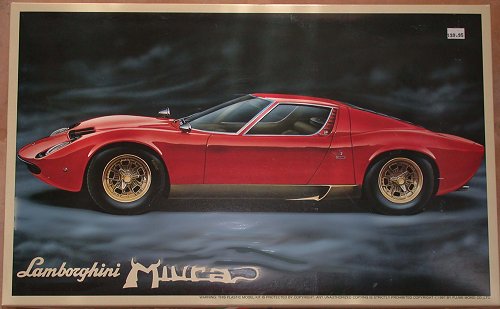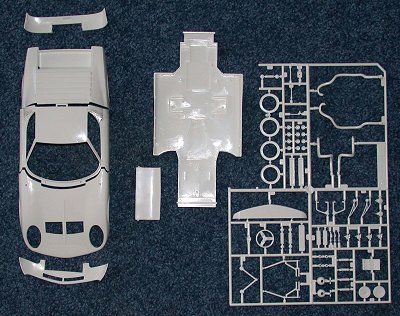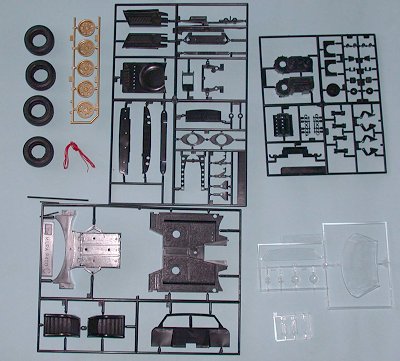
|
KIT: |
Fujimi 1/16 Lamborghini Miura |
|
KIT # |
10147 |
|
PRICE: |
AUD$ 139.95 |
|
DECALS: |
yes |
|
REVIEWER: |
Grenville Davies |
|
NOTES: |

|
HISTORY |
Picture the open shots of the original film The Italian Job. A winding mountain road viewed through the windshield of a low slung car being driven at a quick but seemingly leisurely pace. The scenery changes through tight corners and sheer drop-offs, snow covered ground and blinding sunshine to a tunnel. The car enters the tunnel and there is an explosion from within. A few seconds pass and there is the sound of a large diesel engine coming out of the exit side of the tunnel with the debris of a once spectacular motor car held within the bucket of a front–end loader – a Lamborghini Miura. Its fate is that of its owner, an Italian mobster – to tumble off the side of a huge drop-off into the river winding its way far below. My memories of those opening scenes of a great movie are ones of dismay to see such a phenomenal machine be so callously destroyed all for the sake of a celluloid. I still think it was real, as were my tears! Damn you Pinewood Studios!
The Lamborghini P400 Miura made its debut at the March 1966 Geneva Auto Show, with a bare chassis being displayed at the November 1965 Turin Auto Show. It had a body designed by Marcello Gandini Bertone and was a high performance, two door, two seater berlinetta sports car with the engine sitting slightly forward of the rear wheels, more commonly called a “mid engine” configuration. The car carried the symbol trademark of the company; the Lamborghini Bull named “Miura”, so named after an ancient fighting bull. The model was built between 1966 and 1969 with a total of 475 cars being produced.
The car had a wheelbase of 2.504m, an overall length of 4.370m, overall width of 1.760m and an overall height of 1.050m. It weighed in at 1,292 kg and had a weight distribution of 44/56 front/rear. The chassis was constructed of sheet-steel with welded box sections. The body was of a monocoque steel construction with aluminium front and rear sections. The suspension was all-independent and consisted of double transverse wishbones with coil springs, telescopic shock absorbers and anti-roll bars. The brakes were Girling disc brakes on all wheels, which were hydraulically operated via a dual circuit system. The front discs were 305mm and the rear were 280mm. The steering was of the rack and pinion type and had 3.4 turns lock to lock. The front and rear tyres were Pirelli Cinturato Belted HS 205-15, with 7 x 15 inch Campagnolo cast magnesium rims.
The Miura was powered by a V-12, 60 degree, light alloy block engine, with inbuilt gearbox and differential. It was a rear wheel drive vehicle. The engine had dual overhead camshafts, which were chain driven and the cylinder head had two valves per cylinder. It had a displacement of 3939 cc, with a Bore & Stroke of 82 x 62mm and a compression ratio of 9.8:1. This almost 4 litre engine could produce 350 bhp @ 7000rpm and deliver 369 Nm (271 lbs. ft.) of torque @ 5100 rpm. It had a twin ignition system that comprised of two coils and two Marelli distributors. It had a wet sump and a common engine-transmission lubrication system. Fuel was delivered to the engine via four (4) triple-choke Weber 40 IDA 30 carburettors, used 100 Octane Premium and used about 19.0l/ 100km. It was cooled by cross-flow radiators with twin electric fans.
The Miura had a five speed gearbox with the fourth gear being a direct ratio of 1:1 and the fifth gear an overdrive of 0.815:1. It had a final drive ratio of 4.08:1, which gave the car a maximum speed of 174 mph (approximately 280 km/h) and was touted as having the highest speed of any of the “exotic cars” on the market at that time. It was capable of accelerating from 0 to 100 km/h in 6.7 seconds and 0 to 100 mph in 14.3 seconds. It could manage the quarter mile in 14.6 seconds reaching 101 mph in the process! It had a 90 litre fuel tank and in 1968 cost $19,900 (USD, I assume). These days it can cost anywhere between $45,600 to $79,000 (2003 figures)
It has been surpassed in speed by many models since the late 1960’s, but at the time was a very quick bit of gear that certainly turned heads when it rambled on down the road. It is still one of the most evocative shapes to grace the roads.
|
THE KIT |
 |
 |
The kit comes in a sturdy box with a great side shot of the car on the front. It is classed as an Enthusiast model and has parts that open and close and swivel. You know, all the gimmicky bits marketed to sell some of these kits. All of the sprues, with the exception of the body work are bagged separately. There are two white sprues, although one is the aforementioned body linked by moulding sprues, four black sprues that are mainly concerned with the chassis, engine and interior parts, two clear sprues for the windscreens and lights and one gold sprue for the four main wheel hubs and the spare tyre. The tyres are rubber and there is a coil of wire for the spark plug leads, three metal rods for the axle and front door supports and two screws to hold the front wheels onto the axle stubs. Of the one hundred and fifty odd parts only six are not used. It is one big box for a decent sized car!
There is a small amount of flash and certainly enough ejector pin marks to keep one busy, although for the most part these will be out of sight and mind, some will be prominent when the boot (engine compartment and rear of the vehicle) and bonnet (spare tyre locality and front of the car) are opened and so will need to be cleaned up. The kit was manufactured in November 1997 and lacks some of the detail found in a Hasegawa or Tamiya kit, but Fujimi do tend to hold their own when it comes to car kits, especially in offering the rarer marques.
There is a small decal sheet that has the company logo, car name and number plates and a concise eight page booklet outlining the building process. Painting is called out at each stage with the reference being towards Gunze Sangyo colours. This car is meant to be red, whether you like other colours or not and that is what it will be painted, although perhaps Mr Gunze Sangyo will not be used! The undersides are meant to be gold on this particular exotic machine.
The rubber tyres appear to have a place for a transfer on the side, probably the Pirelli logo, although no such decal can be found in the box. Two mirrors are included in the kit but there is none of the Tamiya niceties with bits of sticky silver to simulate the mirror surfaces. I will just have to resort to using Bare Metal Foil! There is no glass for either door, which hinges on a metal rod. The interior is well-appointed and even has texture on the floor pan to simulate carpet – nice touch!
|
CONCLUSIONS |
It is a bit expensive for a kit of this size, although I have spent as much on smaller kits, even if they are collector’s items and with less detail than is found in this one. I don’t begrudge the money as there are few manufacturers out there who offer the Miura and I do like to build in this larger scale, having built the Ferrari F40 and the Lamborghini Countach by the same manufacturer. I would have liked to see some glass on the doors, but do like the carpet-style texture on the floor pan of the interior. There is more than enough detail within the kit and if you’re anally retentive (Oh, alright! I admit it!), then you could quite easily go to town by adding bits and pieces all over the shop!
I am not fazed with the amount of flash in the kit as it is always necessary to clean up mould lines on the top of guards (fenders) and other areas that seem (no pun intended) to attract the judges eyes. The mouldings are quite crisp and the clear bits are just that, clear.
I am looking forward to the build and adding it to my collection of things four and two-wheeled.
|
REFERENCES |
Lamborghini Cars www.lambocars.com/framed/index.htm
If you would like your product reviewed fairly and quickly by a site that has nearly 250,000 visitors a month, please contact me or see other details in the Note to Contributors.